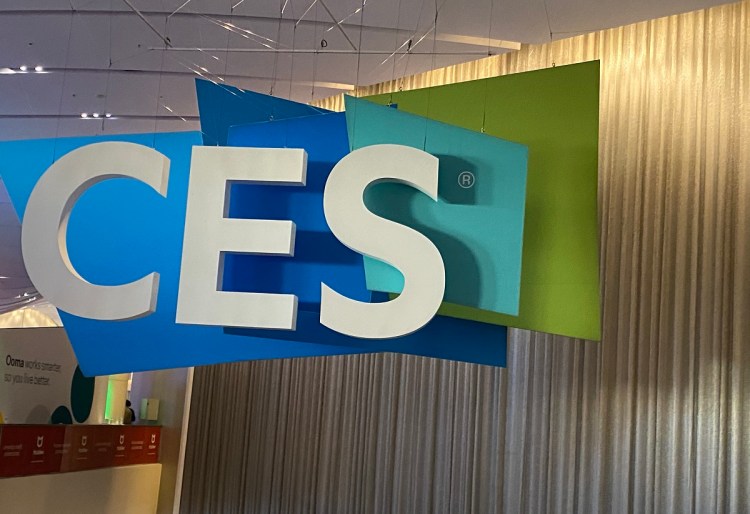I have just about wrapped up my trip to CES 2020, the big tech trade show in Las Vegas. I walked more than 37.45 miles (over 84,385 steps) this week to scout for the best ideas and products of the show.
In the name of consumerism, I took in as much of the 2.9 million square feet and as many of the 4,500 exhibitors as I could manage.
These winners captured my imagination by demonstrating what might be possible with technology or what is practical for products in the near future. Some of the products won’t ship in the next year, and some may never ship. Others are already generating revenue.
Three of the winners were back from last year’s list as they made interesting advances in their efforts to change the world, or my face. P&G Ventures’ Opte, Zero Mass Water, and Impossible Foods have taken impressive strides in the last 12 months.
June 5th: The AI Audit in NYC
Join us next week in NYC to engage with top executive leaders, delving into strategies for auditing AI models to ensure fairness, optimal performance, and ethical compliance across diverse organizations. Secure your attendance for this exclusive invite-only event.
I’ve expanded the group to include a few more fresh winners, so we’ve got 14 on the list this year. I’m glad I traveled the extra distance to see some of these products because they make me a believer again. It’s easy to get jaded and dismiss everything. It’s tempting to skip the show. But I always find that my curiosity takes me back to Las Vegas in search of the magical products that will change our lives.
Some of these picks may not seem impressive on first glance. But they all caught my attention and stayed in my mind throughout the week. I feel like I got another glimpse into our future at CES, just as I have for the last 23 years or so. I’ve included videos where I have them, and I hope you enjoy the ride.
Bzigo indoor mosquito detector
To our great agitation, mosquitoes are adept at avoiding human vision and then attacking us when we aren’t looking. But now we can fight back with computer vision and a laser pointer.
Bzigo spent a few years researching how to spot buzzing mosquitoes, and it showed up at CES with a prototype. Bzigo’s infrared camera uses unique optics and has a processor running computer vision algorithms to actively scan the room, differentiating between a mosquito and other pixel-sized signals, such as dust or sensor noise.
Bzigo trained its AI to recognize mosquitos and their erratic flight patterns. Then it follows them until they get tired and land. Ben Resnick, head of marketing, said in an interview that the product then shines a laser pointer on the spot and it notifies you by a text message that it has found a mosquito. You can then go and kill it.
The team figured it can’t use the laser to kill the mosquito because it’s dangerous to have a high-powered laser zapping things in your home. But the tough part is finding where the mosquito lands.
Delta Airlines/Sarcos Guardian XO Exoskeleton

Above: Guardian XO is an exoskeleton for Delta’s baggage handlers
The mechs are coming. Delta Airlines CEO Ed Bastian showed up to give a keynote speech at CES 2020, and much to our surprise, he brought technology with him.
Bastian and Sarcos Robotics showed off Guardian XO, an exoskeleton that operates just like a mech suit from movies like Aliens. But instead of killing Xenomorphs, this exoskeleton lets luggage handlers save their backs. It enables them to pick up objects that are 20 times heavier than normal. An employee could lift 200 pounds continuously for eight hours.
Delta could implement the tech for baggage handlers as early as this year.
MedWand
MedWand aims to fulfill the potential of telemedicine, inspired by the Star Trek Tricorder, a magical device carried by Dr. Leonard “Bones” McCoy in the 1960s television show that could diagnose and heal injured people, said Samir Qamar, CEO of MedWand.
MedWand has 10 different medical tools, such as a stethoscope, all built into a small handheld device that has software and a camera. It doesn’t do any healing yet, but it can broadcast test results from the patient to the doctor, who can then conduct an office visit remotely.
In real time, the doctor can collect a lot of vital signs and detect and follow numerous medical conditions from across town or around the world. As a physician, Qamar is biased toward allowing doctors to do the diagnosis themselves, rather than having the MedWand use AI to figure out what’s wrong.
The device is expected to be $400, and approval from the Food and Drug Administration is pending.
Hyundai S-A1 flying taxi
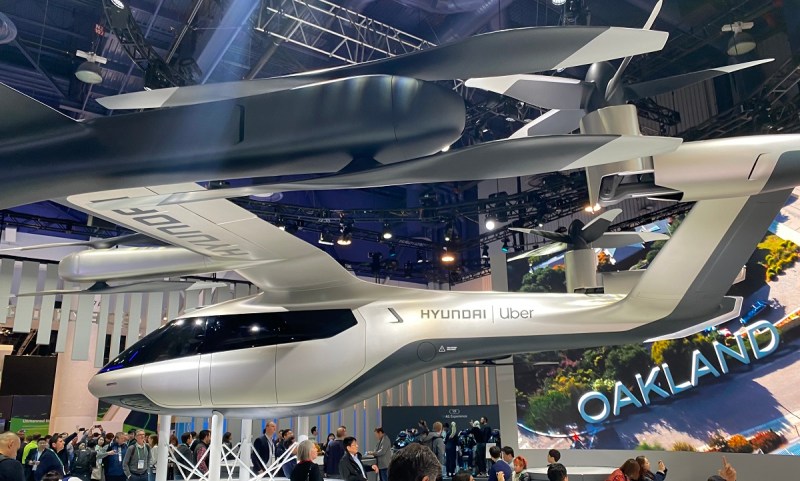
Above: Hyundai’s prototype for an Uber flying taxi.
Hyundai and Uber showed off a prototype for a flying car, an innovation that inventors have dreamed about for more than 100 years.
During its press event, Hyundai showed a small-scale model and a VR trailer of what a future city could look like, with ground transportation hubs where automated shuttles could deliver people. The passengers could then hop aboard a four-seat taxi with a couple of vertical take-off and landing engines. At Hyundai’s booth, the company displayed a full-scale prototype.
The companies still have a long way to go in solving problems like regulatory approval, battery life, and other details. The aircraft has a range of 60 miles, could go 180 miles per hour, and fly 1,000 to 2,000 feet above ground. Let’s hope these guys will get us where we need to go safely.
Toyota’s Woven City
This connected city of the future is purely an idea at this point. But Akio Toyoda, CEO of Toyota, gushed with excitement about it, and he said the automotive company is quite serious about building the town on the site of a former car factory in Japan.
Toyota Woven City will combine a wide array of technologies, including robotics, smart homes, autonomous vehicles, the internet of things, digital health, and sustainable energy. It will be built on 175 acres of land.
It will have streets with three types of lanes: pedestrians, bicycles and scooters, and autonomous vehicles.
The idea is to test how to create a city from the ground up. The company hopes to house Toyota researchers and employees, families, retirees, retailers, students, and more. The company will build the city as a virtual world first, to test ideas and learn from mistakes, Toyoda said.
4moms Mamaroo Sleep Bassinet
Parents of a newborn lose about six weeks of sleep in the first year alone. Those days are a distant memory for me. But plenty of new parents in the thick of this battle are in need of restoring balance and rhythm to their lives. They need to establish a sustainable cycle for their baby’s sleep patterns.
4moms, maker of the Mamaroo baby rocker, recognizes that parents aren’t invincible. So the company has followed up on its Mamaroo infant seat and created a 4moms Mamaroo Sleep Bassinet, which can sway and soothe a baby (see video) using motions that mimic what parents do, said CEO Gary Waters, in an interview with VentureBeat. It can also play noises that put the baby to sleep.
This made me think of a father watching a football game or playing a video game, while trying to cosset a baby. Waters said that we all have these moments where we need a break, and it’s OK to use something like a soothing bassinet to keep a baby happy.
The Bluetooth-enabled bassinet has five rocking, swaying, or vibrating motions, as well as four different white noise options to get your baby to sleep.
Nvidia G-Sync 360Hz esports display
http:/https://youtu.be/3w2PofkHFVQ/
Many TVs and monitors refresh their screens at 60 frames per second, or 60 hertz (Hz). But that’s too slow for gamers, who over the years have been the first to adopt screens that have refresh rates of 120Hz or 240Hz. But at CES, Nvidia and Asus came out with a new G-Sync gaming display technology that can run at 360Hz.
At 360 Hz, the screen is refreshed 360 times a second, or about once every 2.8 milliseconds.
Most TVs operate at 60Hz. In a paper published at Siggraph Asia, Nvidia studied how much better esports players could perform with faster displays. A 60Hz display with a 100 millisecond refresh was the baseline. In Counter-Strike: Global Offensive, flick shot performance improved 28% with 120Hz displays at 54.7 milliseconds and 33% with 240Hz displays at 34.5 millisecond refresh rates. And with 360Hz operating at 20 milliseconds, the performance improvement was 37%.
I played with the new monitor at Nvidia’s place at the show, and I was shocked at how much better I could play a round of Counter-Strike: Global Offensive. When it came to both reaction timing and accuracy, I was able to improve my play greatly. In one test on a 60Hz screen, I couldn’t hit any targets with a sniper scope. But at 360Hz, I hit four targets. On the accuracy test, I hit seven targets in 45 seconds on the CS:GO test on the 60Hz monitor. On the 360Hz monitor, I hit 13 targets.
I also saw another journalist who was better than me run circles around my scores, and he also did much better with 360Hz, as you can see in the video. The 24.5-inch display will debut later this year.
RollBot
Charmin’s vision for a better bathroom includes RollBot. When summoned with a smartphone using Bluetooth, it delivers a fresh roll of toilet paper to you so you won’t be stranded.
Its futuristic design uses self-balancing technology, with a bear-like look to the front panel. I saw it working in Procter & Gamble’s booth at CES. The robots were fairly small, but sturdy enough to deliver a roll of ultra-soft to someone in need.
Charmin notes that people use the bathroom six or seven times a day, and spend on average 156 hours a year on the toilet. But the tech is largely the same as it was a hundred years ago.
Lora DiCarlo Osé Family
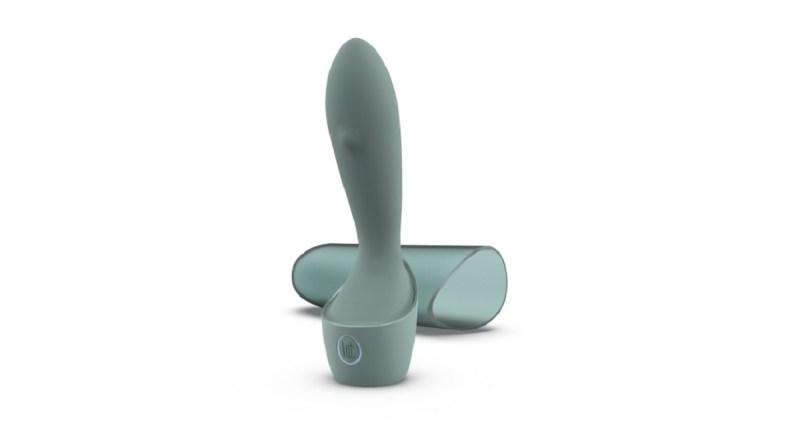
Above: The Osé Onda uses microrobotics to stimulate G-spot orgasms.
I can’t say I’ve tried this orgasm giver-outer. But I did get to see a demo that showed those microrobotics in action at the Pepcom party. Looks like fun to me, and more importantly, it showed that female entrepreneurs such as Lora Dicarlo CEO Lora Haddock could bring diversity and sensitivity to a market that had long been dominated by male-oriented sex companies.
And while there is competition, Lora DiCarlo is the company whose ideas about microrobotics sex toys paved the way for sex-positive products to be on display at CES. Along with other pioneers in the sex tech business such as Lioness, Lora DiCarlo helped convince the Consumer Technology Association that female-friendly technology had as much right to be at the show as male-oriented companies that didn’t have nearly as much technology.
After CTA evaluated this, it restored an award for Lora DiCarlo and let the sex-positive companies back into the CES show floor. More than a dozen sex-tech companies showed up in the health and wellness section of CES this year. Lora DiCarlo brought two new sex toys to the show, demonstrating a commitment to moving the tech forward. The borders of sex tech and porn are still messy. But I believe that the ideas that Lora DiCarlo brought to CES have contributed to a healthy conversation about health and wellness.
Luple Digital Caffeine

Above: Luple’s founders Namsu Lee (right) and Yongduck Kim.
Luple is a South Korean startup that spun out of Samsung to create “digital caffeine.” The team led by CEO Yongduck Kim and CTO Namsu Lee figured out that certain wavelengths of light could have different effects on people. One kind of light-emitting diode (LED) light could make people feel more energetic, and another could make people feel more relaxed so they could go to sleep, Lee said in an interview with me.
If you are studying and want to be able to concentrate, Luple will show you one kind of light. If you are sleepy and want to take a nap, it will shine a different light. The company is studying what kind of wavelength is healthy for the human body, and it says this “human-centric lighting” keeps you more alert than a cup of coffee. And Luple is one of a new group of companies that is leading the way with non-drug treatments for physical problems such as drowsiness or sleeplessness.
Zero Mass Water
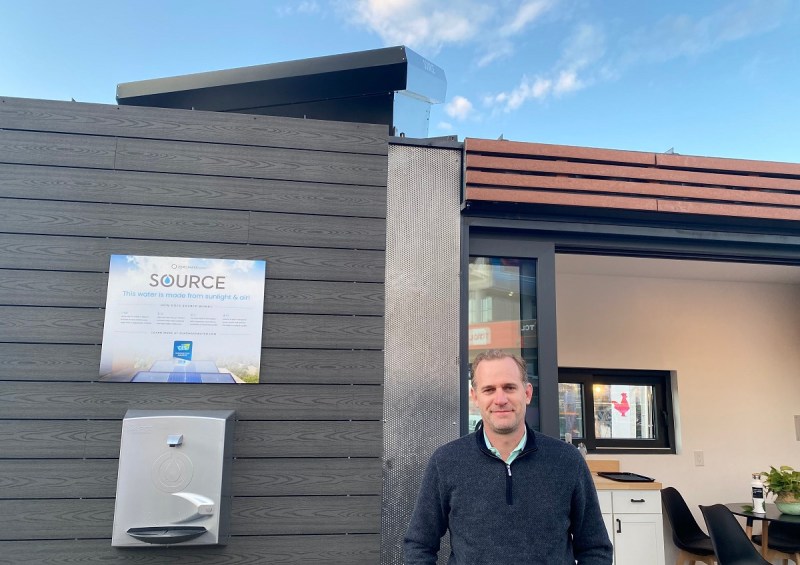
Above: Cody Friesen is CEO and inventor of Zero Mass Water’s Hydropanels that pull water from air..
As I noted last year, Zero Mass Water is one of those companies that will change the world. The technology is like something out of Frank Herbert’s classic science fiction novel Dune. It comes as a time when Australia is in flames and Syria’s ghastly civil war was caused in large measure by a severe drought.
Zero Mass Water created the Source Hydropanel, which can extract water from air and electricity. It does so by using air and solar panels to create the right conditions to speed the process of condensing water from even arid air.
That is magic, as it requires no electrical input, pipes, or public utility infrastructure. It is a way of using the resources that are already in abundance around us — the water that exists in our air. It is the brainchild of Cody Friesen, associate professor of materials science at Arizona State University.
And now the company has some new innovations. The Source Rexi Hydropanel is half the size of the previous version, is easier to install, and can produce more water on a daily basis.
The company is also introducing its new “water-as-a-service” business model. Friesen said in an interview it has deployed multiple Source Fields, or large-scale hydropanel arrays that create an ongoing supply of water for communities and businesses.
In places like Dubai and Australia, cities are purchasing large amounts of Source Field water. Friesen said his own home in Arizona now operates on a couple of Zero Mass Water’s Source Hydropanels, which produce more than 600 bottles of water a month, or more than enough for his family of four. And he lives in the dry air of Arizona.
Once again, I had a chance to drink Zero Mass Water’s water at CES, as I downed a cool cup of the company’s water from a rooftop Source Rexi Hydropanel.
Impossible Pork
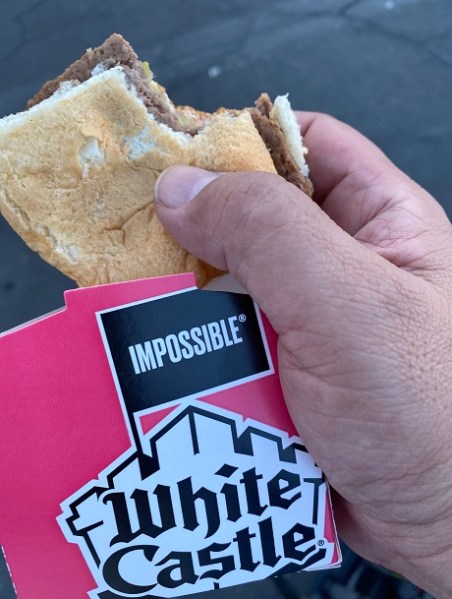
Above: Impossible Foods’ meatless pork.
The Impossible Burger 2.0 is on a mission to save the lives of a lot of cows. And now the company, Impossible Foods, is going to save some pigs too, as our porcine friends are the most popular food in the world.
Last year, Impossible Foods made its debut at CES 2019 and showed off version 2.0 of the Impossible Burger. It tasted much better than its predecessor and other veggie burgers because it was spiced with heme, an iron-containing molecule in blood that carries oxygen and is found in living organisms.
It was founded nine years ago by scientist Patrick Brown, a Stanford professor who felt that our habit of eating meat wasn’t sustainable. Brown figured out that if he could generate a lot of heme from plants, he could recreate the taste of animal meat. Chains such as Burger King have adopted the meatless burger.
And now Impossible Foods has created a meatless version of pork. I tried it out and it tasted good. There’s a lot of tech in this food as well, and let’s hope it will save a lot of pigs. The company’s goal is to eliminate animal farming by 2035.
Opté Precision Skincare Wand
Procter & Gamble showed up at CES 2019 with the Opté Precision Skincare Wand. And it came back this year with an even better version.
It scans your skin with a blue LED light to find your age spots. A microprocessor analyzes the age spots and customizes a serum/makeup combination to instantly to apply to them. It uses inkjet technology to deposit the customized serum to cover each imperfection, careful to avoid putting the serum on non-blemished skin.
I played guinea pig once again, and Thomas Rabe, the inventor of the Opté (funded by P&G Ventures), waved the wand over my face, magically covering up my age spots. It’s only temporary, and lasts about a day, akin to makeup. But the serum can help improve your skin over time.
It took 10 years of development and over 40 patents to bring it to market. Opté, with proprietary algorithms and printing technology, can treat just about any kind of skin. It doesn’t use expensive lasers, lightening creams, or makeup. P&G expects it to come out this year as a premium product, but it hasn’t set the price yet, Rabe said in an interview with VentureBeat.
Honorable mentions
Joué Music Instrument, Gillette Treo shaver for caregivers, Neon, SmellSense, Samsung Ballie, Segway S-Pod, and the Hydraloop Water Recycler were also compelling.
